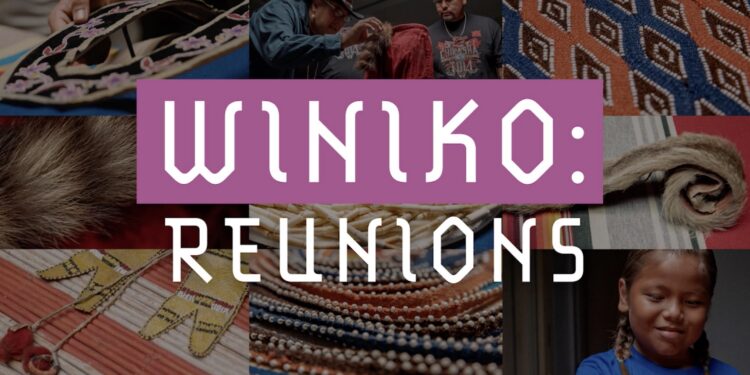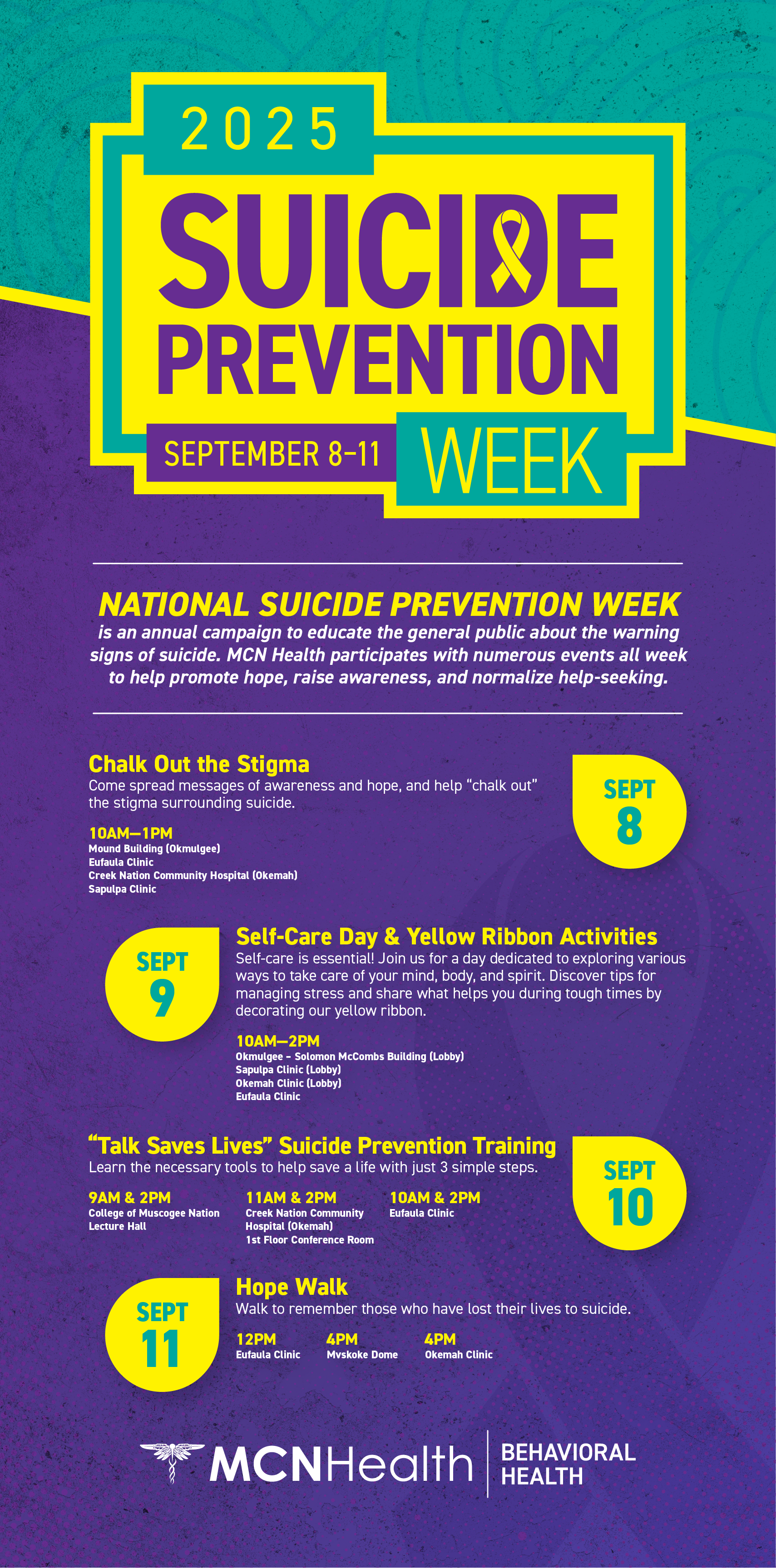This article has been updated from its initial publication on September 30, 2025.
OKMULGEE – On Sep. 27, the First American Museum (FAM) hosted a free screening of the film “WINIKO: Reunions” at the College of the Muscogee Nation Lecture Hall. The documentary, filmed by the Tulsa area Native production team Pursuit Films, highlights the stories of seven Native descendant groups and the items that belonged to their ancestors, long held by the Smithsonian Institution. Of those seven, the Muscogee (Creek) McIntosh family is highlighted, reuniting the descendants of Principal Chief William McIntosh with a finger-woven sash made by his daughter Jane in the early 19th century.
The items featured in “WINIKO: Reunions” are part of the FAM exhibit “WINIKO: Life of an Object, Selections from the Smithsonian National Museum of the American Indian currently on display. The exhibit contains 72 items on loan from the NMAI that FAM connected to 32 living descendant communities and families in Oklahoma.
FAM’s current Assistant Curator John Hamilton (Kiowa/Caddo/Cheyenee/Wichita) and previous project curator and NAGPRA specialist Welana Queton (Mvskoke/Osage/Cherokee) spoke to Mvskoke Media about the exhibit, the documentary process, and working with tribal communities to reunite family histories.
Family names and hidden histories
While overseeing a 2019 loan transfer of items for display from the Smithsonian to FAM in preparation of the museum’s opening, Director of Curatorial Affairs of FAM Heather Ahtone (Chickasaw) and Queton were tasked with tribal consultation that included obtaining information on each object. Items came with notes from the Smithsonian and original fieldnotes taken by the collectors, but FAM wanted more background on the objects.
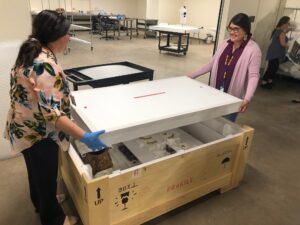
“All these items were collected around the early 1900s, around 1905 to 1912 or so, and these items originally belonged to tribal families and tribes within the early 1900s era and with these items came along these notes from the Smithsonian,” Hamilton explained. “While looking at the notes and information of each item, the person who collected these items around the 1900s period took field notes of what tribe he was visiting, what tribe he was purchasing items from and also names of individuals who he was buying these items from.”
Most of the items were collected by Mark Raymond Harrington on behalf of George Gustav Heye (1874-1957), a prolific collector of Indigenous American artifacts. Heye, a Standard Oil Company heir, founded the Museum of the American Indian in 1922 in New York from his sizable personal collection. In 1989 its collection was transferred to the Smithsonian and became part of the NMAI.
During preparation work for the FAM official opening, Queton began recognizing names that were associated with the items. “What stood out to me was the surnames listed for every tribe. They are still names within our tribal communities. They are names of my friends & relatives. The Harrington field notes are so extensive that I bet each native person in Oklahoma can find a relative listed in the archives,” said Queton.
“And I had a feeling most people today do not know their family’s material culture lives in NMAI collections.”
According to Hamiliton, that recognition sparked an idea, “So it was just the idea of ‘could we maybe connect these items back to these original families that these items belong to?’ and this is well over 110 years later here in Oklahoma City.”
“This is just a maturation, not a repatriation, where we couldn’t give the item back, but as a museum, a Native based museum, we wanted to at least let these family members know that these items once belonged to their ancestor.” – John Hamilton
Life stories, connections and reunions
When the FAM opened in 2021 the reunion project hadn’t officially begun due to funding, although the items on loan were displayed on the museum’s second floor. In 2023, Ahtone was able to expand the department and the project could begin. The team could then start the consultation process- identifying families mentioned in the notes to make connections between items and people.
For Queton, these connections were made in everyday life, “If a certain name or object was of interest to me, I started asking around when I’d go to a tribal function such as a dance, feast, or NAC ceremony. So that’s really where the connections started to be made. And sometimes I would simply ask on FB and friends would say that’s my great-great grandmother/grandfather or give me another tidbit of information,” she shared.
Archival collections from the Oklahoma Historical Society and the University of Oklahoma’s Western Heritage Collections, as well as obituaries, burial records, historical photos and even google searches were utilized to connect stories, objects, and families.
Queton was involved in every aspect of the project from concept and narrative. With the collaboration of Hallie Winter (Osage), Gena Timberman (Choctaw), Zach Rice (Pawnee) and Rance Weryackwe (Comanche), Queton says that the development came to life.
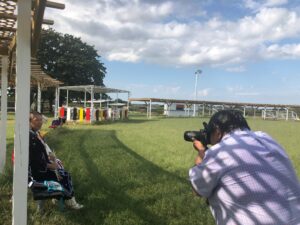
When the consultation process for the exhibit began it included a history of the object and its use, their origin/creation stories, ancestral land bases, removal history, and correct spellings for Tribal names.
The process also included fieldwork and, like the exhibit itself, relied on family connection for Queton. “Once I found a descendant(s) for a certain object I contacted them and set up a date for the photo. I hired my dad, Tom Fields (Mvskoke and Cherokee) and professional photographer, since I could count on him for a quick turnaround to take some of the photos,” Queton said.
“Together we traveled across the state and captured the descendants that you see on the labels,” Queton said. “When available I would also use a historical photo of the object’s original owner noted by Harrigton then put that next to the descendant so a viewer could see the continuity of the family’s existence.”
From 2023 to 2024, FAM was able to connect with 33 of the 39 Tribes affiliated with the items. According to Hamilton, out of the 33 tribes half of those had family members that were able to connect back to those items. The team didn’t want descendants and families to view the items through the display case or have to pay to see their ancestors’ items at the museum.
In the fall of 2024 they planned two months of reunions, bringing families in one at a time to view items out of their display cases. The team brought family members to a private classroom to view the items up close and personal- that’s when families were able to give FAM the history of the item. This is the focus of the film, “WINIKO: Reunions.”
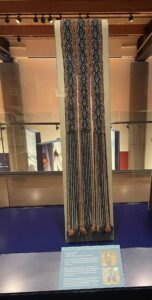
“It was emotional for families when they were reunited with an object. They remembered those ancestors who once owned or used that object. And that became another story in the life of that object. It begins to function, once again, as a continuum of lineage that is disrupted by its purchase, collection and life on a museum shelf. If you think about it, it really parallels our history as Native people. The initial reunions happened right before the exhibitions opened and at the very end of my time at FAM,” Queton said.
Hamilton was able to witness the expressions on the faces of descendants while seeing the items up close. Some had known the item existed, others did not, and the experience was moving and fulfilling for him.
“Museums don’t always have the greatest positive response from the Native communities, of course with museums there’s always been mistrust between museums and tribal communities because museums have always made money off of displaying cultural items and kind of distorting tribal history without consulting first and letting the tribes know what the museums want to do in the first place,” Hamilton said.
“So there’s always been a mistrust with museums, but knowing that as a Native American museum, we’re trying to do the right thing.” While working with Tribal Nations on the project, including the MCN, Hamilton had a positive experience. However, it took time to get to know tribal representatives and it also took time for representatives to be on board with the concept and with the project. Any reluctance that he received was understood, and the whole team worked to make assurances that respect for the communities and descendants came first and foremost.
“Our OK tribal people would see their material culture for the first time, families would see a piece of material culture that was once worn or used by their ancestor, but it still remains behind glass and not in that tribe’s or family’s possession.” – Welana Queton
“Working with the tribes, it wasn’t easy at first and that’s expected but we wanted to just gradually continue and pursue this project because we knew it would be something good for the community and not just good for the museum,” Hamilton said. “I was very happy to work with the Muscogee Nation and just do something good for them, and not just for this museum,” Hamilton said.
The McIntosh sash
Respecting Tribal sovereignty was always carefully considered by the team, who went to Tribal leadership to get their blessings. For the MCN, Hamilton presented the project to Principal Chief David Hill, and from there the team connected with MCN Historic and Cultural Preservation Department Director Robin Soweka, Jr.
Soweka was able to determine three items in the collection were Mvskoke, but only one item had a family connection- a sash belt belonging to Principal Chief William McIntosh.
When selecting pieces to include in the exhibit, the belt had stood out. “The McIntosh belt was chosen because it remains one of the most beautiful pieces in NMAI’s Muscogee collection. In my opinion, its artistry and skill level is still unmatched amongst fingerweavers today. Being Osage too, I’m very familiar with fingerweaving,” Queton shared.

Soweka then connected the team with a Chief McIntosh descendant working within his department, MCN Oral Historian Midge Dellinger (Mvskoke). Dellinger, along with former MCN Principal Chief James Floyd, worked with Hamilton to get the reunion going.
“Mcintosh’s belt is created in a style that many people today think of as only belonging to a woodland fingerweaving style. I wanted to show that this style was also used by many Southeast tribes & even by other tribes located along the furthest Eastern Seaboard. As we know, Chief McIntosh is still very controversial for Muscogee people, but it’s about the artistry of the belt,” Queton said.
Dellinger shared that while she viewed the project as groundbreaking it brought up mixed emotions, “I believe that the staff at First Americans Museum, those involved in this specific project, have done a fantastic job by doing something unprecedented in the museum world, which is to allow lost connections between Indigenous artifacts kept in bondage, some for centuries, and away from the families from which they originated, to be found,” Dellinger wrote. “As a McIntosh descendant, discovering that the Smithsonian has kept since the 1960s a beautiful finger-woven sash belt, over two-hundred years old, worn by Chief William McIntosh, Jr., and made by his oldest daughter, Jane, was exciting, but also very upsetting.”
“To be a part of FAM’s ‘Winiko: Reunions’ project has been a life-changing experience,” Dellinger shared. “As patrons of museum spaces, we expect to view artifacts through glass enclosures, but to have the opportunity to spend private family time with the sash and to be able to touch it, and closely observe the fine intricacies of its beautiful design, and through this process to feel not only a physical, but spiritual connection to my ancestors William and Jane, is an experience I will never forget.”
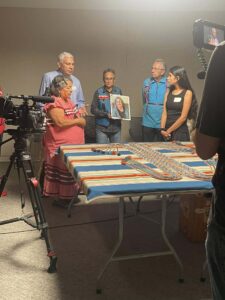
“I can’t put into words the emotional and spiritual impact this experience has had on me.”
Hamilton hopes that after Mvskoke citizens watch “WINIKO: Reunions” they will appreciate that MCN was involved, and he hopes they have a positive experience. Hamilton stresses that moving forward with anything that Tribal citizens want done or displayed on behalf of the MCN, FAM will always go to them and never go behind the Nation’s back.
“We will always try to get the Nations blessing and that we want to be as transparent with everything that we do and it’s always community first before it’s a museum first,” Hamilton said.
“I hope that other museums and repositories who keep Indigenous peoples from things that are inherently ours, including ancestral remains, follow the example of First Americans Museum and allow the reclamation and healing much needed and deserved by Indigenous people.” – MCN Oral Historian Midge Dellinger
Queton echoes the sentiment, “Please know that every step, meeting, etc. along the way was guided by prayer, as I’m taught to do by my family, ancestors and people.”
There are plans to show the documentary at FAM, in addition to an early-August screening attended by some of the McIntosh family, but their efforts are focused on the Tribes. The team wants to make sure that every tribe that was represented in the film will be able to watch it at their own tribal headquarters.
The First Americans Museum is located in Oklahoma City, with visiting hours from 10 a.m. to 5 p.m. The museum is closed on Tuesdays. There are tours for the “WINIKO: Life of an Object” exhibit at 1:00 p.m. To learn more about the museum, visit FAM.
This article has been updated since the date of publication to expand on the curatorial efforts of Welena Queton.


